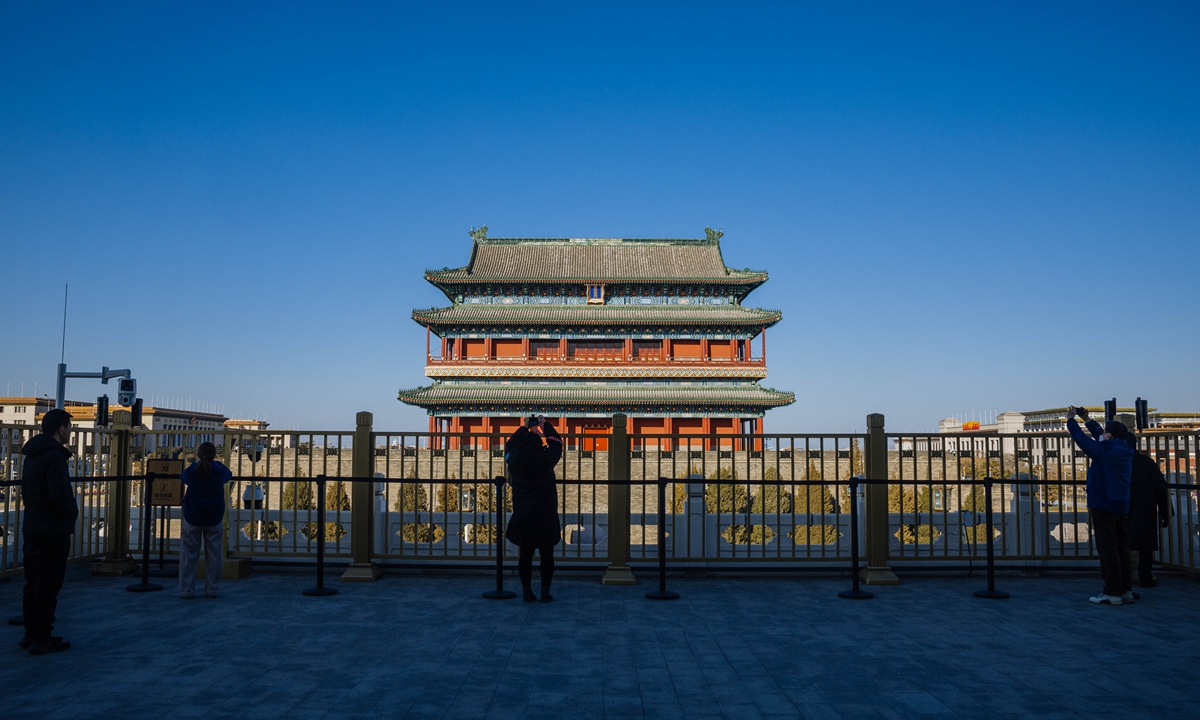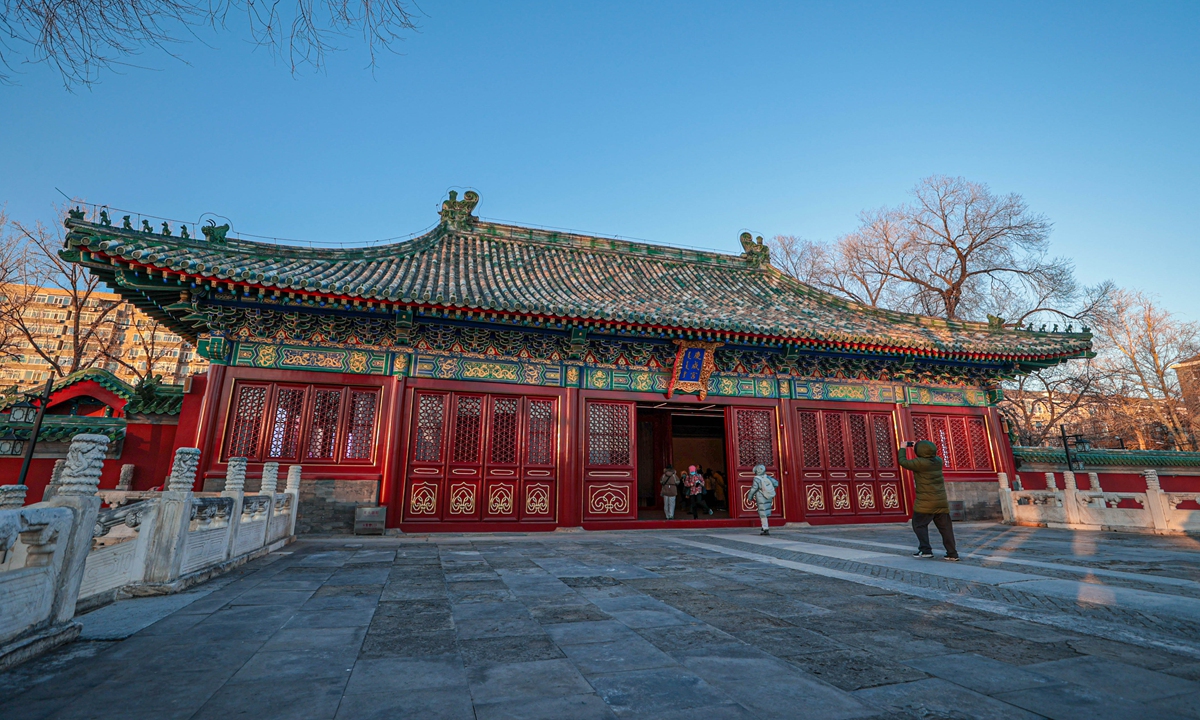
A visitor takes photos of the Zhengyang Gate in Beijing. Photo: Li Hao/GT
A long line wound its way outside the Tourist Information Center for the Arrow Tower of Zhengyang Gate, a newly reopened attraction along the Beijing Central Axis. The visitors, hailing from various places, were unable to secure tickets online but were still eager to scale the refurbished ancient structure with a batch of valued cultural relics at the start of the New Year, hoping to snag tickets on-site.
Since it reopened on December 26, 2024, there have been 800 tickets for the Arrow Tower offered every day to visitors for free, but now all of the tickets, even for dates one week in advance, have been fully booked, a worker at the information center told the Global Times.
"It is best to find a location with faster internet since securing a ticket has become quite challenging," the worker said.
Lü Zhou, director of the National Heritage Center at Tsinghua University, has noticed changes following the Beijing Central Axis' successful application for World Heritage status in July 2024.
Alongside transformations in the urban environment - with new venues such as the Qingcheng Palace and the Zhengyang Gate Arrow Tower opening to the public,this achievement has also resulted in a growing public interest in the Beijing Central Axis.
The success of the bid is just a starting point for the revitalization of the Beijing Central Axis.
As Zhang Lixin, head of the Beijing Municipal Cultural Heritage Bureau, stated at the summary conference on the protection of the Beijing Central Axis held at the end of 2024, efforts to relocate, conserve, and utilize cultural relics in the core areas will be expedited.
This initiative aims to transform the Central Axis into a national demonstration zone for relic preservation, as reported by the People's Daily.
Constantly 'growing'
In the eyes of Dou Junjie, a veteran tour guide, the Central Axis is constantly "growing," despite its origins dating back centuries. Through the preservation of relics and innovations in heritage utilization, the cultural significance of the axis continues to evolve and expand.
Dou has developed several cycling routes for visitors interested in exploring attractions along the Beijing Central Axis. With the increasing guide routes after successful application, he has observed the revitalization of historical areas such as Dashilan and Shichahai, the reopening of historical landmarks, and advancements in digital technologies that monitor the state of ancient architectural structures and showcase the beauty of the axis, including the digital bell at the Bell and Drum towers that uses light and shadow to capture the passage of time, or the contemporary interpretations of traditional opera in Qianmen Street.
The more Dou delves into the Central Axis, the more impressed he is with these comprehensive and innovative protection measures. Taking the Qingcheng Palace complex with a history of more than 500 years and opened to the public for the first time in December 2024 as an example, conservation efforts for the Beijing Central Axis have helped relocate residents, demolish non-heritage buildings, and restore the site, allowing the complex to be brought back into public view.
The main hall of the Qingcheng Palace complex, an imperial sacrificial venue along the historic Beijing Central Axis Photo: VCG
"Today, the Beijing Central Axis encompasses not only traditional attractions along its 7.8-kilometer stretch but also modern landmarks like the National Stadium. Its evolving cultural significance reflects and enriches our cultural confidence," Dou told the Global Times.
The application for its World Heritage status has accelerated the relocation of residents around the key cultural relics and historical buildings, strengthening the efforts in cultural heritage protection, and the improvement of surrounding environments along the central axis.
Now the restoration and revitalization of the central axis are part of the urban construction of the capital, Liu Zheng, a member of the China Cultural Relics Academy, told the Global Times.
Integrating into modern life
"Deepening public participation is another effective method for revitalizing the ancient central axis and enhancing the protection of cultural relics," Liu noted.
Liu added that in order to fully integrate world heritage into urban life, it is insufficient to focus solely on restoring tangible architectures; instead, it is essential to plan and launch complementary cultural activities as well as create art and literary works to accomplish the interpretation of the Beijing Central Axis culture that can be rooted in people's hearts.
Fang Zhe, a Beijing local, noted that the Bell Tower and Drum Tower near his home are more "open and practical" as it is enriched with cultural events and performances, especially after acquiring the World Heritage status. For instance, he remembered an art event themed on the intangible cultural heritages of China hosted at the Drum Tower in December 2024, which drew lots of young people wearing Hanfu and holding a tanghulu (sugarcoated haws on a stick) prop while taking on-site photos and posting them on social media platforms.
"I can see restorations of the architectural bodies and sites such as the bell and drum towers are being carried out. However, the restoration is just a process of preserving such heritages to become ready for interaction with the public and one of the ways of systematic conservation," Fang said.
"The value of the Central Axis has to be landed in people's everyday life," Fang noted.
Fang's belief has driven him to establish a theater program, for which multiple microfilms were produced along the Beijing Central Axis.



